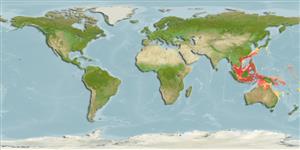Environment: milieu / climate zone / depth range / distribution range
Ökologie
seewasser demersal. Tropical
Western Pacific: Hainan, China to Thailand and Indonesia.
Size / Gewicht / Alter
Maturity: Lm ? range ? - ? cm
Max length : 18.0 cm TL Männchen/unbestimmt; (Ref. 42740)
Rückenflossenstacheln (insgesamt) : 4 - 5; Rückenflossenweichstrahlen (insgesamt) : 20 - 24; Afterflossenstacheln: 1; Afterflossenweichstrahlen: 16 - 20. Upper half of body with 7 dusky bars containing 3 or 4 dark brown dots in their lower part, the last 6 as 3 pairs. Below each pair, on lower side, a large dusky blotch. 2 small dark brown spots, one above the other, at base of caudal fin. Anterior rays of soft portion of dorsal fin prolonged and filamentous in large adults), the second to fourth longest, 1.7 to 3.8 in standard length (over the range of 6.7 to 11.4 cm standard length)
Possibly on mud bottoms (Ref. 42740).
Life cycle and mating behavior
Geschlechtsreife | Fortpflanzung | Ablaichen | Eier | Fecundity | Larven
Randall, J.E., 2001. Pinguipedidae (= Parapercidae, Mugiloididae). Sandperches. p. 3501-3510. In K.E. Carpenter and V. Niem (eds.) FAO species identification guide for fishery purposes. The living marine resources of the Western Central Pacific. Vol. 6. Bony fishes part 4 (Labridae to Latimeriidae), estuarine crocodiles. FAO, Rome. (Ref. 42740)
IUCN Rote Liste Status (Ref. 130435: Version 2024-1)
Bedrohung für Menschen
Harmless
Nutzung durch Menschen
Fischereien: nicht kommerziell
Tools
Zusatzinformationen
Download XML
Internet Quellen
Estimates based on models
Preferred temperature (Ref.
123201): 15.2 - 27.9, mean 23.7 °C (based on 412 cells).
Phylogenetic diversity index (Ref.
82804): PD
50 = 0.5000 [Uniqueness, from 0.5 = low to 2.0 = high].
Bayesian length-weight: a=0.00692 (0.00314 - 0.01524), b=3.06 (2.88 - 3.24), in cm total length, based on LWR estimates for this Genus-body shape (Ref.
93245).
Trophic level (Ref.
69278): 3.5 ±0.4 se; based on size and trophs of closest relatives
Widerstandsfähigkeit (Ref.
120179): hoch, Verdopplung der Population dauert weniger als 15 Monate. (Preliminary K or Fecundity.).
Fishing Vulnerability (Ref.
59153): Low vulnerability (10 of 100).
